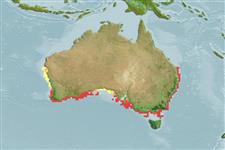>
Clupeiformes (Herrings) >
Clupeidae (Herrings, shads, sardines, menhadens)
Etymology: Hyperlophus: Greek, hyper = over + Greek, lophos = crest (Ref. 45335).
More on author: Castelnau.
Environment: milieu / climate zone / depth range / distribution range
Ecologia
marinhas; estuarina; anfídromo (Ref. 51243); intervalo de profundidade 10 - 13 m. Temperate; 25°S - 40°S, 112°E - 155°E (Ref. 188)
Western Pacific: southern Australia, from Kalbarri, Western Australia to South Australia, New South Wales and Moreton Bay, Queensland.
Tamanho / Peso / Idade
Maturity: Lm ? range ? - ? cm
Max length : 10.0 cm SL macho/indeterminado; (Ref. 188)
Descrição breve
Chaves de identificação | Morfologia | Morfometria
Espinhos dorsais (total) : 0; Raios dorsais moles (total) : 12 - 18; Espinhos anais: 0; Raios anais moles: 16 - 27. Body fairly elongate, belly keeled, with 19 to 24 - 10 to 13 scutes; 23 to 27 dorsal scutes with low keels from head to dorsal fin origin. Second supra-maxilla paddle-shaped, lower portion larger. Branchiostegal rays 4. Anal fin origin an eye diameter or more behind base of last dorsal fin ray. Scales more or less firm on body; a silvery band along flank.
Schools in large numbers in shallow sandy areas of bays and estuaries.
Life cycle and mating behavior
Maturidade | Reprodução | Desova | Ovos | Fecundidade | Larvas
Whitehead, P.J.P., 1985. FAO Species Catalogue. Vol. 7. Clupeoid fishes of the world (suborder Clupeoidei). An annotated and illustrated catalogue of the herrings, sardines, pilchards, sprats, shads, anchovies and wolf-herrings. FAO Fish. Synop. 125(7/1):1-303. Rome: FAO. (Ref. 188)
Categoria na Lista Vermelha da IUCN (Ref. 130435: Version 2024-1)
Ameaça para o homem
Harmless
Utilização humana
Pescarias: pescarias de subsistência; isco: usually
Ferramentas
Relatórios especiais
Descarregue XML
Fontes da internet
Estimates based on models
Preferred temperature (Ref.
123201): 15.3 - 23.6, mean 18 °C (based on 193 cells).
Phylogenetic diversity index (Ref.
82804): PD
50 = 0.7500 [Uniqueness, from 0.5 = low to 2.0 = high].
Bayesian length-weight: a=0.00389 (0.00180 - 0.00842), b=3.12 (2.94 - 3.30), in cm total length, based on all LWR estimates for this body shape (Ref.
93245).
Nível Trófico (Ref.
69278): 3.4 ±0.45 se; based on food items.
Resiliência (Ref.
120179): Elevada, tempo mínimo de duplicação da população menor que 15 meses (Preliminary K or Fecundity.).
Fishing Vulnerability (Ref.
59153): Low vulnerability (10 of 100).
Nutrients (Ref.
124155): Calcium = 168 [73, 338] mg/100g; Iron = 0.858 [0.448, 1.717] mg/100g; Protein = 18.7 [17.3, 20.0] %; Omega3 = 0.695 [0.331, 1.479] g/100g; Selenium = 6.96 [2.61, 17.54] μg/100g; VitaminA = 26.6 [8.4, 86.4] μg/100g; Zinc = 1.19 [0.78, 1.84] mg/100g (wet weight);
